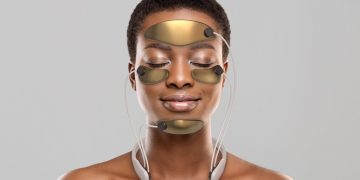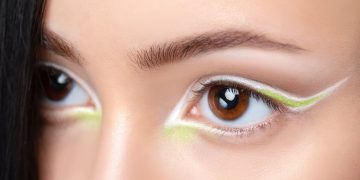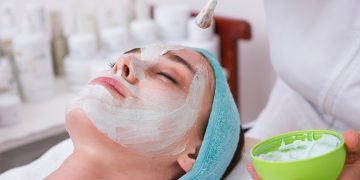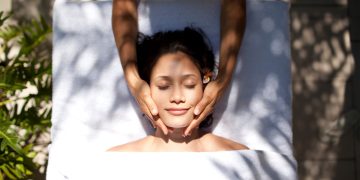Combination skin is a common skin type that presents its own unique set of challenges. People with combination skin typically have different areas of their face with different needs: the T-zone (forehead, nose, and chin) is often oily, while the cheeks, around the eyes, and other areas may be dry or normal. Achieving balance for combination skin requires a thoughtful skincare routine that addresses both oiliness and dryness without exacerbating either.
In this article, we’ll guide you on how to achieve a comprehensive and balanced skincare routine for combination skin, offering tips on how to balance these two contrasting concerns and selecting the best products.
What Is Combination Skin?
Combination skin occurs when the face exhibits characteristics of more than one skin type. The T-zone tends to be oily, while the cheeks and other areas of the face may feel dry or tight. This type of skin is often genetic but can also result from environmental factors like weather, humidity, or stress.
Key characteristics of combination skin:
- Oily T-zone: The forehead, nose, and chin (known as the T-zone) tend to produce excess oil, often leading to clogged pores, blackheads, or acne.
- Dry or Normal Cheeks: The cheeks and outer parts of the face may be dry or even flaky, lacking moisture.
- Uneven Texture: You may notice that certain areas of your face are smooth and hydrated, while others feel rough or lack moisture.
The goal for combination skin is to create a skincare routine that manages oil production in the T-zone while keeping the skin’s drier areas hydrated.
Skincare Routine for Combination Skin: Balancing the Oily and Dry Areas
To achieve a balanced and healthy complexion, the key is customization. You need to address both the oiliness in your T-zone and the dryness or dehydration in other areas. Below is a comprehensive skincare routine tailored to combination skin, covering the essential steps to create balance and harmony.
1. Gentle Cleansing (Morning and Night)
Why It’s Essential:
Cleansing is the first step in any skincare routine, but for combination skin, it’s important to find a cleanser that doesn’t strip the skin of its natural oils or add excessive moisture. Harsh or overly drying cleansers can irritate the skin, while overly creamy cleansers may clog pores in the oily areas.
What to Look For:
- Gel-based or Foaming Cleansers: These formulas are great for balancing oil production while maintaining hydration in dry areas.
- Non-stripping, Hydrating Cleansers: Choose a gentle, pH-balanced cleanser that cleanses without over-drying the skin.
Recommended Ingredients:
- Salicylic Acid (BHA): A mild exfoliant that works well for oilier T-zones by clearing pores and preventing breakouts.
- Glycerin: A hydrating agent that helps maintain moisture in drier areas of the face.
- Aloe Vera: Soothes the skin and balances moisture levels.
Example Products:
- CeraVe Foaming Cleanser
- La Roche-Posay Effaclar Purifying Foaming Gel
- Neutrogena Hydro Boost Hydrating Cleanser
How to Use:
- Cleanse twice daily, in the morning and evening, using a gentle amount of product. Be sure to rinse with lukewarm water, as hot water can strip moisture from both oily and dry areas.
2. Toning (Optional)
Why It’s Essential:
Toners can help balance the skin’s pH after cleansing and prepare your skin for subsequent treatments. For combination skin, look for toners that hydrate while controlling oil.
What to Look For:
- Alcohol-Free Toners: Avoid alcohol-based toners, as they can dry out the skin in areas where it’s already dehydrated.
- Balancing Toners: Choose toners that contain both hydrating and oil-controlling ingredients, which help balance the T-zone and moisturize the drier areas.
Recommended Ingredients:
- Witch Hazel: A natural astringent that helps to minimize oiliness in the T-zone without drying out the skin.
- Hyaluronic Acid: Draws moisture into the skin and helps keep it hydrated.
- Niacinamide: Regulates oil production and soothes the skin.
Example Products:
- Klairs Supple Preparation Unscented Toner
- Thayers Alcohol-Free Witch Hazel Toner
- Pixi Glow Tonic (contains glycolic acid and witch hazel)
How to Use:
- Apply the toner after cleansing, either with a cotton pad or by patting it into the skin with your hands. Follow with serums or moisturizers.
3. Targeted Treatments (Serums)
Why It’s Essential:
Serums are concentrated treatments that can target specific skin concerns. For combination skin, it’s essential to use serums that address oil control without drying out the skin.
What to Look For:
- Hydrating Serums: These should be applied to the dry areas to boost hydration.
- Mattifying Serums: In the T-zone, a lightweight, oil-controlling serum can help balance the excess oil.
- Niacinamide or Salicylic Acid: For oil control and pore-minimizing effects, niacinamide or salicylic acid serums can target the T-zone.
Recommended Ingredients:
- Niacinamide: Reduces excess sebum production and helps even out skin tone.
- Hyaluronic Acid: Deeply hydrates without clogging pores or causing greasiness.
- Salicylic Acid (BHA): Helps clear clogged pores, especially beneficial for the oily areas of the face.
Example Products:
- The Ordinary Niacinamide 10% + Zinc 1%
- La Roche-Posay Effaclar Pore-Refining Serum
- Vichy Minéral 89 Hyaluronic Acid Serum
How to Use:
- Apply a few drops of serum to your face after toning, focusing on areas that need specific treatment.
- Allow the serum to fully absorb before applying moisturizer.

4. Moisturizing (Morning and Night)
Why It’s Essential:
A good moisturizer is vital for maintaining hydration and keeping the skin balanced. For combination skin, you’ll need a moisturizer that hydrates without causing breakouts in the T-zone.
What to Look For:
- Gel-based or Oil-free Moisturizers: Lightweight and hydrating, these are ideal for oily T-zones without clogging pores.
- Non-comedogenic Products: Choose moisturizers that won’t clog pores, especially in the T-zone.
- Balancing Moisturizers: Look for moisturizers that hydrate the skin while controlling oil production.
Recommended Ingredients:
- Hyaluronic Acid: A great hydrator that doesn’t clog pores or add excess oil.
- Ceramides: Help repair and maintain the skin’s barrier function.
- Glycolic Acid: Gently exfoliates and helps to balance the skin’s moisture levels.
Example Products:
- Neutrogena Hydro Boost Water Gel
- CeraVe AM Facial Moisturizing Lotion with SPF 30
- Clinique Dramatically Different Hydrating Jelly
How to Use:
- Apply moisturizer to your face and neck after serums, focusing on areas that need more hydration (e.g., cheeks, under eyes).
- If you use a gel moisturizer in the T-zone and a richer one for dry areas, feel free to layer them.
5. Sunscreen (Morning)
Why It’s Essential:
Sunscreen is an absolute must for all skin types, including combination skin. UV rays can damage the skin and worsen both dryness and excess oil production. A good sunscreen protects your skin from harmful UV rays while keeping it moisturized.
What to Look For:
- Oil-Free or Gel-based Sunscreens: These formulas are hydrating but not greasy, making them ideal for combination skin.
- Broad-Spectrum SPF 30 or Higher: Always opt for a sunscreen with at least SPF 30 to ensure adequate protection.
Recommended Ingredients:
- Hyaluronic Acid: Many sunscreens now incorporate this ingredient to help provide hydration.
- Titanium Dioxide or Zinc Oxide: Mineral sunscreens are often gentler and less likely to irritate the skin.
Example Products:
- EltaMD UV Clear Broad-Spectrum SPF 46
- Neutrogena Ultra Sheer Dry-Touch Sunscreen SPF 55
- La Roche-Posay Anthelios Melt-in Sunscreen Milk SPF 60
How to Use:
- Apply sunscreen as the last step in your morning routine, ensuring full coverage on your face and neck.
- Reapply every two hours if exposed to the sun for extended periods.
Additional Tips for Maintaining Balance in Combination Skin
- Exfoliate Gently: Exfoliating once or twice a week can help remove dead skin cells, balance oil production, and maintain healthy skin. However, avoid over-exfoliating, as it can aggravate dryness.
- Use a Clay Mask for the T-zone: Once a week, apply a clay mask to your T-zone to absorb excess oil and clear clogged pores.
- Don’t Skip the Moisturizer: Even though your T-zone is oily, your cheeks may still need hydration. Avoid skipping moisturizer, as this could worsen dryness in certain areas.
- BePatient: Combination skin can be tricky, and finding the right products may take time. Monitor how your skin responds and adjust your routine accordingly.
Conclusion:
Balancing combination skin requires a customized skincare routine that addresses both the oily T-zone and the dry areas of the face. By incorporating gentle cleansers, targeted treatments, balanced moisturizers, and sun protection, you can achieve smooth, healthy skin. With the right approach, combination skin can be well-managed, and you’ll enjoy a balanced complexion that feels hydrated and controlled, without excess oil or dryness.












































